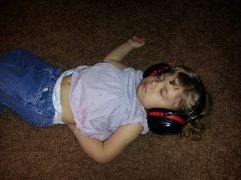What is Sensory Overload?
The term sensory overload is sometimes used in the wrong context and not within its true meaning and definition. You may hear people using the terms sensory meltdown or sensory dysregulation when referring to sensory overload. Sensory overload can happen, and does happen to all of us, not just children with sensory processing challenges. (The exception to this rule is the case of a child who under-registers all forms of sensory input, who may never "feel" sensory overload.)
Definition of Sensory Overload:
When the brain and nervous system is bombarded with too much sensory input from one or more sensory systems and is unable to process and sort out the incoming sensory messages.
Why is Sensory Overload so Common?
Our fast-paced, hectic, competitive, chaotic society has created the perfect recipe for sensory overload. There are more and more sounds and lights, and the sense of peace and living a simple life is gone. Technology is taking over with no regard for the sensory systems. For example, the automatic dryers in many public bathrooms. They are as loud as a jet taking off! These loud, abrupt sounds are enough to send anyone in to sensory overload.
Picture this...
A public bathroom with automatic flushing toilets and hand dryers, strong chemical air fresheners puffing out toxins every 2 minutes, bright overhead fluorescent lights, and the bathroom door slamming open and shut. And in this bathroom a mother with her infant on the diaper changing stand and two children at her side, one age 3 and the other age 5 ...the mother being overwhelmed and stressed because one child is late for gymnastics and the other one has a play date at the McDonald's play land. The children are crying, and feel the tension and stress. Out of the bathroom they go, only to get back in the car to head to point B, where everyone is in a hurry, road rage, people honking at one another...and the mother is on the cell phone checked out from her kids, or trying to sneak and text in her lap as she is driving to the next point, talking with her friend who is stressed about her job. Oh, and the children are tossed packaged preservative and carb based snacks and some sort of sugar and dye based drink to help tide them over until dinner.
Ok, I will stop there. Aren't you on the brink of sensory overload just reading this? I sure am.
A Few Possible Signs of Sensory Overload:
Key Points:
How to Help Sensory Overload From Turning in to a Sensory Meltdown:
Definition of Sensory Overload:
When the brain and nervous system is bombarded with too much sensory input from one or more sensory systems and is unable to process and sort out the incoming sensory messages.
Why is Sensory Overload so Common?
Our fast-paced, hectic, competitive, chaotic society has created the perfect recipe for sensory overload. There are more and more sounds and lights, and the sense of peace and living a simple life is gone. Technology is taking over with no regard for the sensory systems. For example, the automatic dryers in many public bathrooms. They are as loud as a jet taking off! These loud, abrupt sounds are enough to send anyone in to sensory overload.
Picture this...
A public bathroom with automatic flushing toilets and hand dryers, strong chemical air fresheners puffing out toxins every 2 minutes, bright overhead fluorescent lights, and the bathroom door slamming open and shut. And in this bathroom a mother with her infant on the diaper changing stand and two children at her side, one age 3 and the other age 5 ...the mother being overwhelmed and stressed because one child is late for gymnastics and the other one has a play date at the McDonald's play land. The children are crying, and feel the tension and stress. Out of the bathroom they go, only to get back in the car to head to point B, where everyone is in a hurry, road rage, people honking at one another...and the mother is on the cell phone checked out from her kids, or trying to sneak and text in her lap as she is driving to the next point, talking with her friend who is stressed about her job. Oh, and the children are tossed packaged preservative and carb based snacks and some sort of sugar and dye based drink to help tide them over until dinner.
Ok, I will stop there. Aren't you on the brink of sensory overload just reading this? I sure am.
A Few Possible Signs of Sensory Overload:
- Irritability
- Nervous
- Quick change of mood
- Crying
- Attempt to block out incoming sensory input (such as covering ears, hiding face, trying to flee a situation, etc)
- Glazed over look or "checked out" look
- Falling asleep unexpected
Key Points:
- Sensory overload does not mean something is wrong with the child.
- Sensory overload is not the same as a sensory meltdown. Although sensory overload is a precursor and trigger for a sensory meltdown.
- Sensory overload is common for a neuro-typical brain, but can occur at a much greater extent and frequency for a child with sensory processing challenges.
- One can recover and return to ready state and regulated without full dysregulation and fight or flight taking over. This is where sensory tools and strategies come in to play as well as watching for the sensory signals your child gives you....
- Our society and environment has very little regard for our sensory systems and needs, we must adapt, and avoid the best we can, and be acutely aware of our surroundings to protect our sensory systems.
How to Help Sensory Overload From Turning in to a Sensory Meltdown:
- Take note of your child's environment at all times. Keep it calm and keep it simple. Avoid the triggers when at all possible.
- Watch for signs and sensory signals of possible overload and respond right then and there. Don't push through.
- Slow down. Make time for the transitions in the day.
- Enjoy the moment and simple things in life. A schedule packed from morning to night is not healthy for anyone.
- Let your kid be a kid. Let them lead the way and explore their little world. Build a pillow fort and play in the mud. Play with a cardboard box.
- Stay organized. Maintain a predictable and reasonable schedule.
- Be sure to incorporate calming and organizing sensory activities throughout the day.
- Offer regular and frequent sensory retreat breaks throughout the day.
- Take deep breaths often with your child throughout the day.
- Keep it Real. Keep it Simple. Keep it Sensory.


